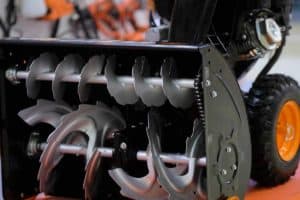 When its time to buy a snow blower, things can get overwhelming. Besides the different brands, each one differ in their configuration and features. It’s important to understand the basics before beginning your shopping. It will help you purchase the correct snow blower for your needs.
When its time to buy a snow blower, things can get overwhelming. Besides the different brands, each one differ in their configuration and features. It’s important to understand the basics before beginning your shopping. It will help you purchase the correct snow blower for your needs.
There are five types of snow blowers to choose from. They are single-stage, two-stage, three-stage, electric, and battery-powered. They differ in size, power, surface type, clearing width and of course price. Choosing the correct type for you is the most important decision you can make.
It should be noted that there is no “wrong type”. Each option is built to handle a specific set of conditions. Not just in the amount of snow you’ll receive, but in how easy it is to handle and store. There is no use buying an expensive, powerful snowblower if you only receive a few light snow falls each year. On the other hand, saving a few bucks buying an under-powered unit when you routinely get heavy snow might end up being a costly mistake.
Single-Stage Snow Blower
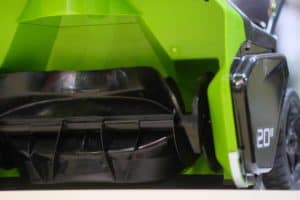 These gas-powered machines have the simplest design and come in at a lower price. A corkscrew auger spins in the front breaking up snow and launching it through an attached discharge chute. All the power comes through that high-speed auger.
These gas-powered machines have the simplest design and come in at a lower price. A corkscrew auger spins in the front breaking up snow and launching it through an attached discharge chute. All the power comes through that high-speed auger.
These units are lightweight and small which make them easy to maneuver in tight spaces. They typically range between 18 and 24 inches in width. Their lower height results in only handling around 8-10 inches of snow at a given time. They typically lack a self-propelled element.
Since the rubber-tipped auger makes contact with the surface and the auger moves at high speeds, it should not be used on the lawn or gravel surfaces. This can lead to tearing up grass or turning rocks into high speed projectiles. Stick to paved driveways and sidewalks.
A single-stage gas powered snow blower is best for those who get light to moderate snow. Those with smaller paved driveways and sidewalks that don’t have a big slope. While they can handle removing high quantities of snow, they can struggle with the heavier wet variety (found at the end of the driveway). View our list of the top rated single stage snow blowers of 2019.
Two-Stage Snow Blower
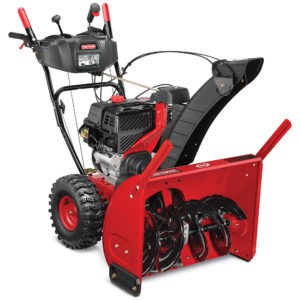 This machine uses two devices to remove snow. The corkscrew-shaped slow-turning auger will suck up the snow from the ground. A fan which is known as an impeller will then help push that snow from the back of the auger and out through the chute. This allows for more snow to pass through the machine and launch it further through the air.
This machine uses two devices to remove snow. The corkscrew-shaped slow-turning auger will suck up the snow from the ground. A fan which is known as an impeller will then help push that snow from the back of the auger and out through the chute. This allows for more snow to pass through the machine and launch it further through the air.
Two-stage models are bigger and heavier. Their larger auger can chew through compacted ice and snow much easier. Since the auger does not touch the ground, they can be used on gravel and concrete surfaces. Taller buckets mean they can handle over 20 feet of snow (like the end of a driveway). The high-speed impeller prevents the chute from clogging up too.
Despite their size, they can be just as easy to maneuver. Many have a self-propelled mechanism that allows for controlling at multiple forward and reverse speeds. This makes it easy to plow through a long stretch of snow without slowing down.
This type of snow blower is built for efficiently removing large amounts of snow. They can handle the light and heavy variety on all surface types. Best for those in snowy climates with medium-to-large sized driveways. They are pricey, but you get what you pay for. Check out our list of the best two stage snow blowers of 2019.
Three-Stage Snow Blower
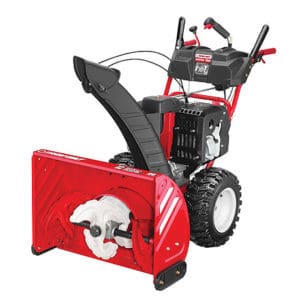 The latest fad in the snow removal industry is the three-stage snow blower. This model is similar to the two-stage blower that features an auger and impeller fan. But in the middle is an accelerator that chops up the snow and pushes it through the impeller.
The latest fad in the snow removal industry is the three-stage snow blower. This model is similar to the two-stage blower that features an auger and impeller fan. But in the middle is an accelerator that chops up the snow and pushes it through the impeller.
This model is made for the worst Mother Nature can throw at it. Powering through the thickest snow and ice, it can handle over 20 inches of snow of the wet and heavy variety. According to Consumer Reports, it can also do so 30 percent faster than its two-stage counterpart. This more expensive option is like a two-stage blower on steroids.
Those looking at a three-stage snow blower should live in climates that receive heavy snowfalls. It can handle high snowdrifts and the heavy snow that piles up at the end of the driveway The distance it can discharge snow makes it great for wider driveways while its speed is ideal for longer ones.
Electric Snow Blower
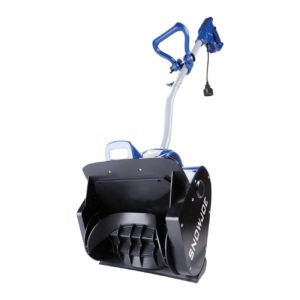 For light snow removal, an electric model might be a great choice. These machines are typically priced much lower than their gas-powered rivals. They act as single-stage units where an auger powers snow up through a discharge chute. They can handle snow falls up to 8 inches and can throw snow about 30 feet.
For light snow removal, an electric model might be a great choice. These machines are typically priced much lower than their gas-powered rivals. They act as single-stage units where an auger powers snow up through a discharge chute. They can handle snow falls up to 8 inches and can throw snow about 30 feet.
Besides price, going electric provides the best maneuverability. They’re incredibly lightweight and can be found as narrow as 12 inches in width. Almost no maintenance is required as they don’t need oil changes or gas fill-ups. No dealing with a pull cord start-up or messy emissions either. You are limited to how far your weather insulated extension cord can reach.
Corded electric snowblowers are for areas that receive light to moderate snow of less than 8 inches at a time. They are for paved surfaces that do not have much of a slope. Sidewalks, single-car driveways, and decks are ideal. Some people use these in conjunction with a larger gas-powered one for areas that are hard to reach.
Cordless Electric Snow Blower
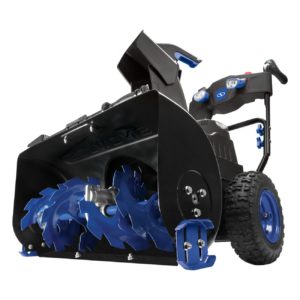 If you like the idea of electric but hate having to maneuver around a cord, battery-powered may be for you. Advancement in lithium battery technology has made these machines much more powerful over the years. Most come in the single-stage variety, although there have been some newer models that are two-stage.
If you like the idea of electric but hate having to maneuver around a cord, battery-powered may be for you. Advancement in lithium battery technology has made these machines much more powerful over the years. Most come in the single-stage variety, although there have been some newer models that are two-stage.
These machines are lightweight and narrow. They are quieter than gas-powered blowers and eco-friendly. A great choice if you want to plow during odd hours but don’t want to wake up the neighbors. There is little to no maintenance and they don’t require a pull cord start.
Power is your primary concern with a cordless snow blower. They can handle 8-10 inches of snow but are at the mercy of a battery which gives you 30-60 minutes per charge. When the battery is draining, power can wain. It can struggle with heavy snow found at the end of a driveway.
Consider a battery-powered electric snow blower if you get light to moderate snow. Its best for smaller, paved driveways that do not have a heavy slope. Also an option for those who are on a budget but need some assistance with snow removal.
Before deciding on which type is right for you, figure out where and when it will be used. Research the snowfall averages in your region. And when you’ve done that, you can move on to deciding which snow blower features are best for you.
